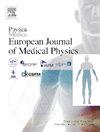两种生物有效剂量计算模型在单次分次立体定向放射手术中的应用比较
IF 3.3
3区 医学
Q1 RADIOLOGY, NUCLEAR MEDICINE & MEDICAL IMAGING
Physica Medica-European Journal of Medical Physics
Pub Date : 2024-09-27
DOI:10.1016/j.ejmp.2024.104820
引用次数: 0
摘要
背景最近的研究表明,生物有效剂量(BED)与单次分量立体定向放射外科治疗效果之间存在密切联系,前庭裂隙瘤(VS)、动静脉畸形和垂体腺瘤的治疗效果就证明了这一点。目的 本研究的目的是量化均匀剂量投放简化模型与包含剂量投放的时空递增和亚致死损伤修复的双指数效应的更复杂模型所计算出的 BED 值之间的差异。方法 开发了一种软件工具,可根据从 GammaPlan(Elekta)治疗计划中提取的单个等中心剂量矩阵计算 BED 分布。利用两组不同肿瘤体积和等中心数的 5 个 VS 和 5 个颈静脉裂孔型耳鸣瘤病例来对该方法进行基准测试。结果两种模型计算出的覆盖 98% 肿瘤体积的 BED 与治疗时间呈近似线性关系。在所有研究病例中,均匀给药模型都高估了全时空给药模型计算出的 BED。结论尽管 BED 分布与均匀剂量给药简化模型相似,但它们提供的大量 BED 测量值比用均匀剂量给药简化模型计算的唯一外围 BED 值更适合描述临床结果。本文章由计算机程序翻译,如有差异,请以英文原文为准。
Comparison of two biologically effective dose calculation models applied to single fraction stereotactic radiosurgery
Background
Recent studies suggest strong correlations between Biologically Effective Doses (BED) and single fraction stereotactic radiosurgery treatment outcomes, as demonstrated for vestibular schwannomas (VS), arterio-venous malformations and pituitary adenomas. The BEDs calculated in these studies consider an uniform dose delivery where the spatio-temporal aspects of dose delivery were neglected.
Purpose
The aim of the study is to quantify the discrepancies between the BED values calculated with a simplified model of uniform dose delivery against the more complex model that incorporates the temporo-spatial incrementation of dose delivery and the bi-exponential effect of the sub-lethal damage repair.
Methods
A software tool that computes the BED distributions based on individual isocenter dose matrices extracted from the GammaPlan (Elekta) treatment planning was developed. Two cohorts 5 VS and 5 jugular foramen schwannoma cases of various tumor volumes and isocenter number were utilized to benchmark the method. Their BEDs covering 98% of tumor volumes were compared against those determined with the uniform delivery model.
Results
The BEDs covering 98% of the tumor volumes as calculated with both models show an approximately linear dependency with the treatment time. For all studied cases, the uniform delivery model overestimates the BEDs calculated with the full spatio-temporal delivery model. This discrepancy seems to accentuate with the tumor volume and treatment complexity.
Conclusions
Despite their resemblance, the BED distributions provide a plethora of BED measures more suitable to characterize clinical outcomes than the unique peripheral BED value calculated with the simplified model of uniform dose delivery.
求助全文
通过发布文献求助,成功后即可免费获取论文全文。
去求助
来源期刊
CiteScore
6.80
自引率
14.70%
发文量
493
审稿时长
78 days
期刊介绍:
Physica Medica, European Journal of Medical Physics, publishing with Elsevier from 2007, provides an international forum for research and reviews on the following main topics:
Medical Imaging
Radiation Therapy
Radiation Protection
Measuring Systems and Signal Processing
Education and training in Medical Physics
Professional issues in Medical Physics.

 求助内容:
求助内容: 应助结果提醒方式:
应助结果提醒方式:


